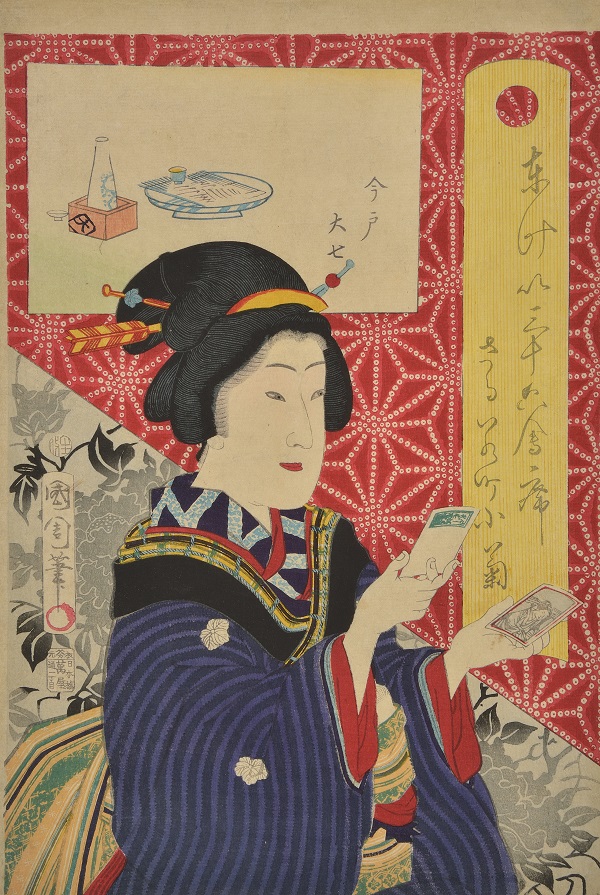 As a Corporate Partner of Watts Gallery – Artists’ Village, we are delighted to share news about the charity’s next exhibition.
As a Corporate Partner of Watts Gallery – Artists’ Village, we are delighted to share news about the charity’s next exhibition.
Opening on 19 March, Edo Pop presents a selection of 19th-century Japanese woodblock prints from the private collection of art historian and writer, Frank Milner. Focusing on the period 1825 – 1895, this will be the first public display for a number of these works, which were hugely popular in 19th-century Japan and also in Europe, where prints were collected by artists including Rossetti, Whistler, Van Gogh and Monet.
With its origins in the 8th century when it was used to reproduce Buddhist texts in black and white, Japanese woodblock printing flourished in the 19th century by which time the prints had evolved to become colourful ukiyo-e – images of the floating world ––and they were produced and collected in their thousands.
At this time, Edo was the world’s largest city, a bustling metropolis with more than 1 million residents. The exhibition features images of Edo in its 19th century heyday, showing thousands of people from all walks of life enjoying festivals including summer fireworks and acrobatic feats by the rival fire brigades that kept Edo safe.
Celebrity was a key feature of this culture, and prints of star actors, sumo wrestlers, beautiful women and more were amongst the most popular. In fact, 75% of all Japanese woodblock prints from this period were of Kabuki actors, such as An Oiran, c.1830, by Kikagawa Eizan (1787 -1867).
Whilst images of geisha and oiran – the highest courtesans – are well-known, this exhibition also includes images of women in more domestic and working roles that will be less familiar, such as Abalone Divers,1886 by Toyohara Kunichika (1835-1900) and 3am Mother with Crying Baby, 1890, Toyohara Kunichka (1835-1900).
At the heart of Edo was the Yoshiwara, the city’s famous entertainment district. It was open to ordinary people, many of whom were not wealthy enough to enter its high-class brothels or tea houses, but who enjoyed spending time in the area to buy street food or watch entertainers. Samurai were not permitted to enter, but as Samurai rivals clash in The Yoshiwara, 1827, Utagawa Kunisada (1786-1864) shows, they often disguised themselves to meet their lovers there.
Identified by the two swords they had permission to wear, Samurai were required to spend a large part of the year in Edo. Their courage in battle was greatly admired, and historical battles often featured in Kabuki plays, such as Battle of Fujikawa River in 1180, c.1847 by Utagawa Yoshitora (active 1840-1880). Samurai symbolised ideal male beauty, epitomised in Kikagawa Eizan’s (1787-1867) Young Samurai with a Hawk, c.1830
By the 1850s, Edo and its thriving society made other nations curious and keen to establish new markets in Japan for their goods. In 1854, America forced Japan to open its ports to international trade, and what followed was a period of great change. In 1868 and under a new government, Edo became Tokyo, and the final section of the exhibition focuses on images of the Modern City. Steam trains, photography, rickshaws (invented in 1869) start to appear in prints such as The Geisha Kogiku looking at photographs, 1870 by Toyohara Kunichika (1835-1900).
Frank Milner said: “I have been collecting these prints for nearly fifty years and have them hanging all over my house – they cheer me up. I love their modern feel, extremely bright colours, quirky perspectives, as well as their daring and hugely imaginative compositions. We forget that these are Victorian! To me it seems no wonder that Van Gogh, Manet, Degas, Lautrec and other artists were completely bowled over when they first saw prints like these in the 1860s and 70s. We sometimes think that Japanese prints are mostly about landscape but they’re actually about people and I am mostly interested in the cultural and political side of things. I am delighted to be working with Watts Gallery to share highlights from my collection.”
Demonstrating the enduring influence of woodblock printing, the exhibition also features new work by artist Hiroko Imada, who will create a site-specific installation in the Sculpture Gallery. Born in Tokyo (modern-day Edo), Imada has exhibited internationally, including at the British Museum and Coventry Cathedral.
And the exhibition will inspire a season of special events and activities across Watts Gallery – Artists’ Village, including talks, workshops, performances and an exhibition of contemporary Japanese prints in Watts Contemporary Gallery.
To find out more: wattsgallery.org.uk
Smith Greenfield has partnered with Watts Gallery Trust – the charity responsible for maintaining Watts Gallery – Artists’ Village – to offer its Friends, Patrons and members access to its expert insurance services. And, through a special arrangement, when Friends of the Gallery take out or renew a policy through Smith Greenfield the charity will receive a donation. For further information, please visit wattsgallery.org.uk

